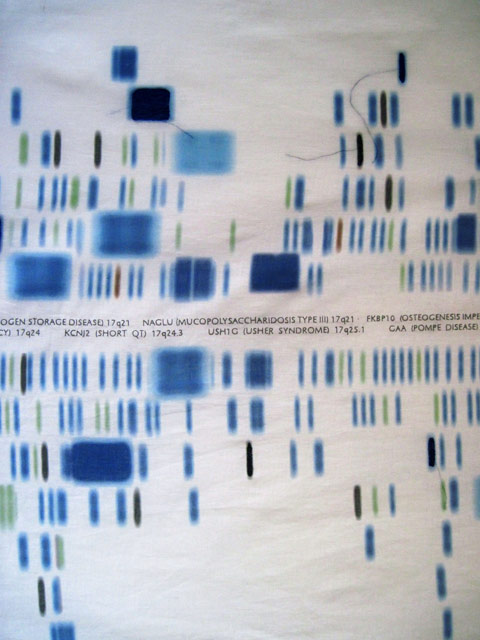Chromosome 17
Work on Exhibit
Chromosome 17 2011
Cloth panels, sateen and cotton voile, hand embroidered with the genetic sequence for chromosome 17, steel case, plexi 9' x 3’ x 6"
A permanent work commissioned by the department of Medical Genetics at the University of Washington, in honor of the 50th Anniversary of Medical Genetics and its founder Dr. Arno Motulsky. This commission was coordinated and overseen by independent curator and public scholar, Genevieve Gaiser Tremblay. 2011
Artists Statement
In 2009 the department of Medical Genetics at the University of Washington commission me to make a work that would both commemorate 50 years of Medical Genetics and honor the founder, Dr. Arno Motulsky. Dr. Arno Motulsky created the Medical Genetics department at the University of Washington in 1957, the first of its kind in the United States. More than one thousand genes have since been identified by researchers there.
The artwork entitled "Chromosome 17" uses the National Center for Biotechnical Information (NCBI)'s database to access the Human Genome master map of gene sequences. Each graphic in the work represents a marker and location of a gene that codes for significant characteristics or anomalies. Chromosome 17 was used for this work because it contains markers for Ovarian Cancer and Breast Cancer, which were discovered at the University of Washington, and Growth Hormone Deficiency, which has been studied specifically at the University of Washington's Medical Genetic department.
The artwork is composed of two layers of cloth, printed, painted and embroidered with graphics that represent the genetic structure of chromosome 17. One sheer and one thick piece of cloth are layered to create depth in the space of the steel and plexiglass box, which houses the work. The colors and marks on the chromosome were enlarged, the colors enhanced, and many were hand-embroidered to visually emphasize particular genetic qualities. The gene sequence thus appears as a mosaic of layered blue and green tones. Significant terms and graphics such as pedigree maps, pharmacogenetics, and ecogenetics are engraved on the plexiglass plate that protects the cloth.
The commission was completed in consultation with Robin Bennett, M.S., C.G.C., Ph.D.,Senior Genetic Counselor & Co-Director of the Genetic Medicine Clinics at the University of Washington, and Peter H. Byers, M.D. Professor of Medicine and Pathology Adjunct Professor of Genome Sciences and Reed College alumnus from 1969. It was in Peter's lab that I first discovered the Human Genome master map of a gene sequence graphic for Chromosome 17.
The work honors Arno G. Motulsky, M.D., active Professor Emeritus of Medicine and Genome Sciences. Motulsky was a founder of the field of pharmacogenetics, which concerns the interaction between genetic variation and drug responsivity. He currently studies the role of genetic polymorphisms in resistance and susceptibility to disease caused by environmental agents at the Center of Ecogenetics.
Dr. Motulsky received many honors including election to the National Academy of Science (NAS), the Institute of Medicine of the NAS, the American Association of Arts and Sciences, and the American Philosophical Society. In addition to his scientific activities, Dr. Motulsky is interested in the social impact of human genetics, including genetic testing, and has participated in national committees that address these issues.
Collaborators
Peter H. Byers, M.D.
Professor of Medicine and Pathology,
Adjunct Professor of Genome Sciences,
Adjunct Professor of Oral Biology, University of Washington
Research Program
Our objectives are to understand the molecular pathogenesis of inherited disorders of connective tissue. We have focused on disorders that affect collagen genes and the enzymes involved in the post-translational modification of collagens. The clinical disorders include varieties of osteogenesis imperfecta, of Ehlers-Danlos syndrome, and of some other disorders of vascular integrity. These disorders result from mutations in the type I collagen genes (COL1A1 and COL1A2), the type III collagen genes (COL3A1), type V collagen genes (COL5A1 and COL5A2), and some additional genes such as those involved in prolyl 3-hydroxylation (CRTAP and LEPRE1), and the TGFB receptor genes (TGFBR1 and TGFBR2). These mutations affect mRNA processing and transport, protein assembly and folding, molecular transport within the cell, and molecular processing and fibril aggregation in the extracellular matrix. We are trying to understand the mechanisms by which the cell recognizes and adapts to mutations that affect splicing, chain assembly and molecular transport as well as to define the manner in which mutations produce the phenotypes. The strategies to reach these goals include the analysis of the normal and altered order of splicing in complex genes, isolation of procollagen binding proteins by direct immunoprecipitation of bound proteins, analysis of pathways of intracellular degradation, and analysis of changes in gene expression within cells that harbor these mutations.
Robin Bennett , M.S., C.G.C., Ph.D. Hon.
Senior Genetic Counselor & Co-Director, Genetic Medicine Clinics, University of Washington
Background
Since graduating in 1984 from the Sarah Lawrence Human Genetics Program, Ms. Bennett has served as Senior Genetic Counselor and Clinic Manager for the University of Washington Medical Genetics Clinics. She is certified in genetic counseling by the American Board of Medical Genetics and the American Board of Genetic Counseling. She currently serves as the Senior Genetic Counselor and Co-Director of the Genetic Medicine Clinic and is a Clinical Associate Professor in the Division of Medical Genetics in the Department of Medicine.





